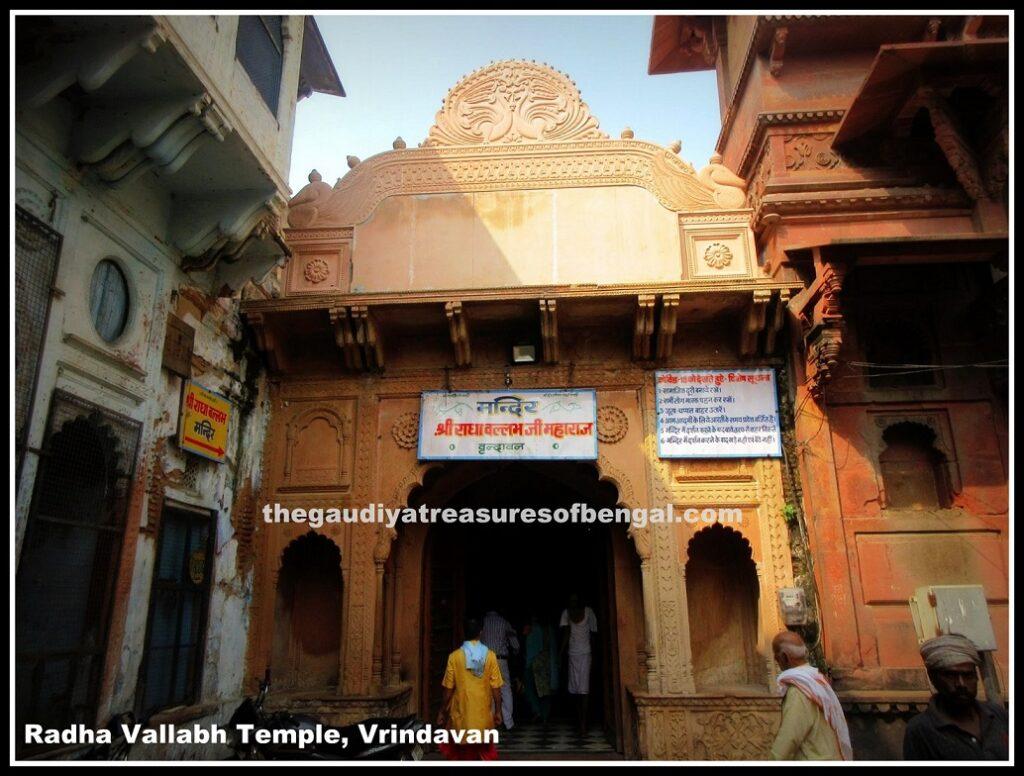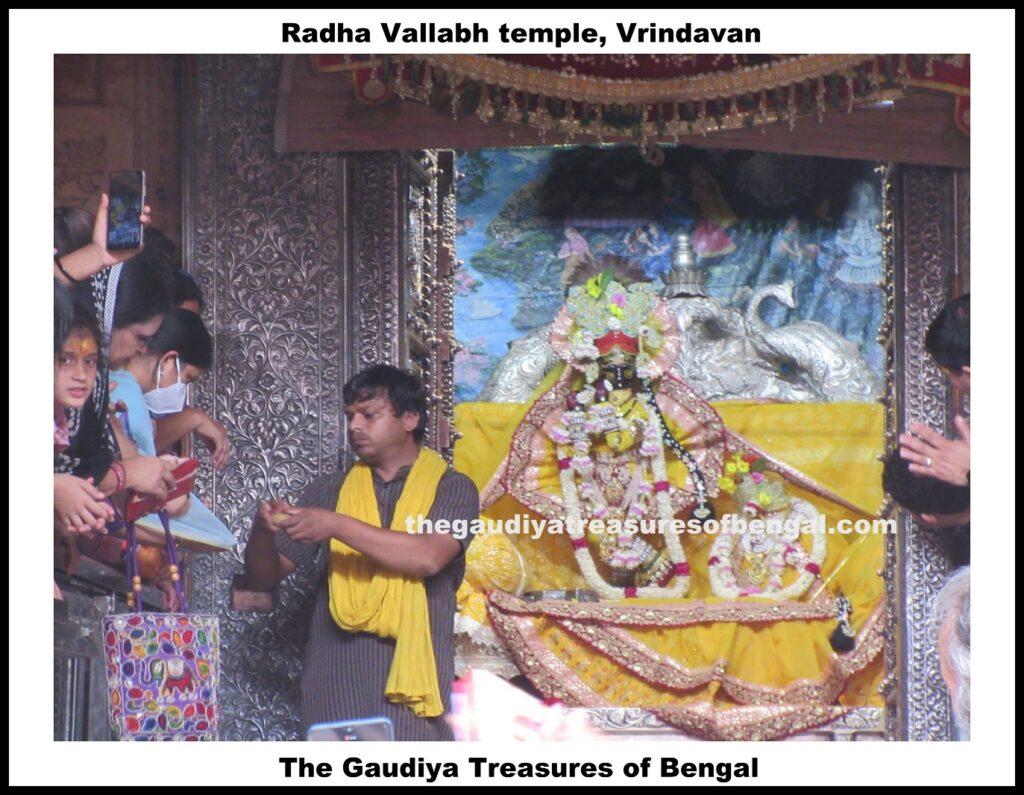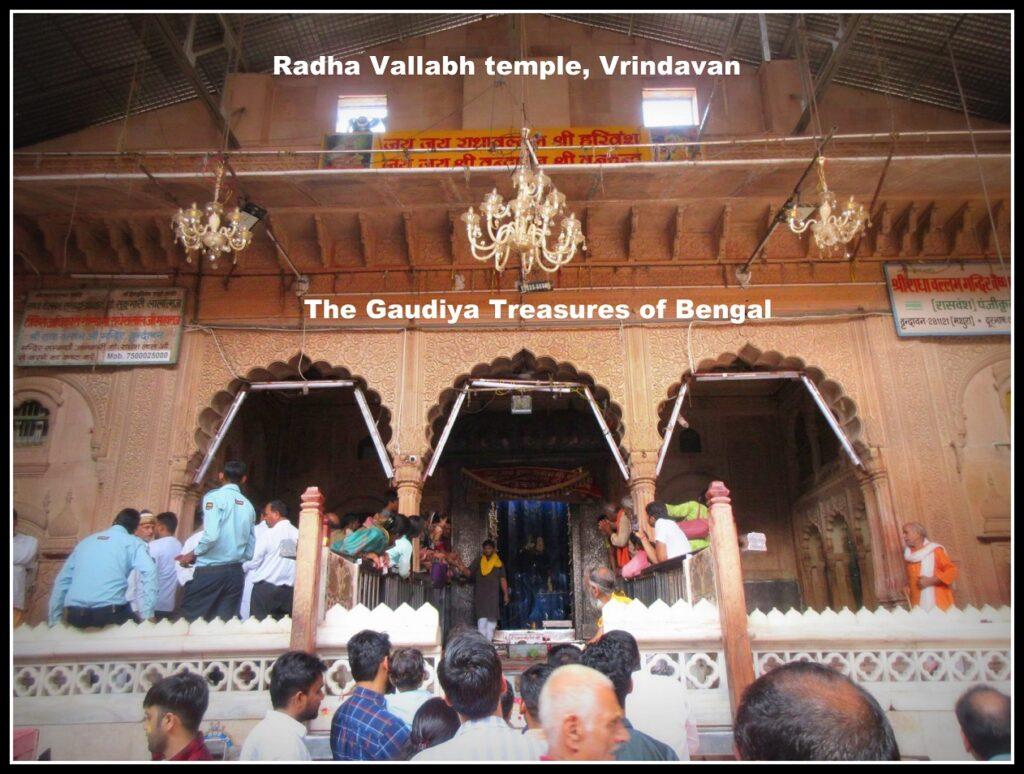 Nestled just a stone’s throw away from Banke Bihari Mandir, lies the magnificent Radha Vallabh temple. This temple is home to the revered deities of Sri Sri Radha Vallabh Ji, who were worshiped by the great saint Sri Hit Harivansh ji Maharaj. Legend has it that Sri Hit Harivansh Maharaj was an incarnation of the ‘vamsi’ or flute of Lord Krishna himself. He descended to spread the inner confidential teachings which emphasize the sublime loving exchanges between Radha and Krishna.
Nestled just a stone’s throw away from Banke Bihari Mandir, lies the magnificent Radha Vallabh temple. This temple is home to the revered deities of Sri Sri Radha Vallabh Ji, who were worshiped by the great saint Sri Hit Harivansh ji Maharaj. Legend has it that Sri Hit Harivansh Maharaj was an incarnation of the ‘vamsi’ or flute of Lord Krishna himself. He descended to spread the inner confidential teachings which emphasize the sublime loving exchanges between Radha and Krishna.
As one approaches the temple, they must ascend a flight of stairs and navigate through a winding lane before finally arriving at the temple courtyard. Once inside, they are greeted by the breathtaking darshan of Sri Sri Radha Vallabh Jiu. Interestingly, while the altar does not feature a separate deity of Radharani, the deity of Radha Vallabh Ju boasts a long braid cascading from their crown. According to the Rasika Vaishnavas of Vrindavan, this is because not everyone is eligible to see the confidential form of Srimati Radharani. Thus, the deity is a ‘yugal jodi’, meaning that both Radha and Krishna are together in one body. The long braid and hair of Radha Vallabh Ji is believed to represent that of Srimati Radharani.
Appearance of Sri Hit Harivansh Maharaj
His Divine Grace Goswami Sri Hit Harivansh ji Maharaj, the founder of the Sri Radha Vallabh Sampradaya, was born into a family of Gaur Brahmins in Deoband, located in the Saharanpur district of Uttar Pradesh. His father, Sri Vyas Mishra, was in the service of the Moghul Emperor Humayun and accompanied him on his march from Agra on one occasion.
It was during this march that Sri Vyas Mishra’s wife, Tara, gave birth to a son at the Royal Army Camp at Bad, near Mathura. This momentous occasion occurred on the 11th day (Ekadashi) of Monday in the Samvat 1530. The parents named the child Hari Vansha, which means “Hari’s issue,” in grateful recognition of their answered prayers.

The birth of Hari Vansha was celebrated with great pomp and splendor by the Emperor, his sister Gulbadan Begum, and prominent courtiers, including Beiram Khan, Tardi Beg, Yaqoob Beg, Zauhar Aftabchi, Dost Baba, and Khoja Amber. The festivities lasted for ten days and included profuse lighting, fireworks, feasts, and other grand celebrations.
Gulbadan Begum, in her book “Humayaunnama,” which is preserved in the Gulistan Library in Tehran, Iran, and Zauhar Aftabchi, in his book “Tazkirat-ul-Wakiat,” described in detail the celebrations that marked the incarnation of the sacred flute of the Lord. Gifts and greetings were sent to Pt. Vyas Mishra, and alms were given to beggars and gifts to courtesans.
During this period of celebrations, one part of the Royal caravan was stationed at the Jamalpur Serai, located three Kos away from Bad on the Agra-Delhi Road. Festivities in honor of Hit Harivansh Maharaj were held on a large scale for ten days and were supervised and managed by Abdul Majeed, the then Dewan of Mathura, at the Royal expense. By the order of the Emperor, all the inmates of the Royal caravan abstained from alcoholic drinks and non-vegetarian food during this period.
Deity of Radha Vallabh ji
Legend has it that the enchanting statue of Sri Radha Vallabh jiu is a divine blessing bestowed upon one of Lord Shiva’s devotees, Sri Atmadev, as a reward for his unwavering devotion and prayers. It is said that when Hit Harivansh Maharaj was 32 years old, he embarked on a journey with the determination to reach Vrindavan. Upon reaching Charthawal, near Muzaffarnagar, he had a vision while sleeping at night. In this vision, Sri Radha appeared to him and commanded him to meet a Brahman who possessed her deity. She instructed him to take this deity to Vrindavan for worship and to marry the Brahman’s two daughters.

This same dream was also given to Atmadeva Brahman. The following morning, Hit Harivansh Maharaj participated in a simple yet solemn wedding ceremony and was given the deity, which he named Radha Vallabh. It is said that this was a divine act of grace, as the deity of Radha Vallabh was considered to be the very essence of the divine presence of Sri Radha herself. This was a significant turning point in the establishment of the Sri Radha Vallabh sect, as the deity of Radha Vallabh became the focal point of the sect’s worship and devotion.
Temple Architecture
Radha Vallabh temple is a remarkable architectural marvel that beautifully embodies the interplay between Hindu and Islamic architectural styles of the medieval era. The temple’s walls, boasting an impressive thickness of 10 feet, are punctuated in two stages, with the upper stage being a regular Triforium that can be accessed by an internal staircase. Interestingly, the Triforium is a fine reproduction of Mohammedan designs, while the rest of the temple’s work, both above and below the Triforium, features purely Hindu architecture.
This temple is the last one in the vicinity that has retained its nave, and its unique style has become so obsolete that its distinct name has been forgotten by some architects. Nonetheless, the temple remains an architectural masterpiece characterized by its emphasis on harmony of lines and balanced massing, and its constructional unity is more striking than its richness of ornamentation. If there were ever a way to bring the past back to life or revive a bygone art style, Radha Vallabh temple would be the perfect one for our architects to study and emulate.
How to Reach
To reach the mesmerizing Radha Vallabh Temple in Vrindavan, one must first make their way to the vibrant and bustling town of Vrindavan, a sacred pilgrimage site for Hindus. Once in Vrindavan, the temple can be found nestled next to the illustrious Banke Bihari Temple, a significant landmark in the town.
The temple’s location next to the Banke Bihari Temple makes it easily accessible for those already exploring the area. Visitors can stroll along the narrow and bustling streets of Vrindavan, taking in the vibrant atmosphere of the town and stopping at the various shops selling religious souvenirs and offerings for the temple deities. The Radha Vallabh Temple can be found at the heart of the town, a spiritual oasis amidst the hustle and bustle.
For those traveling from further afield, the nearest major city is Agra, which is approximately 75 kilometers away. From Agra, visitors can take a taxi or a local bus to reach Vrindavan. Alternatively, those arriving by train can take the Mathura Junction railway station, which is just 15 kilometers away from the temple town. From there, they can take a taxi or a local bus to reach the Radha Vallabh Temple and immerse themselves in the spiritual beauty of this remarkable place.